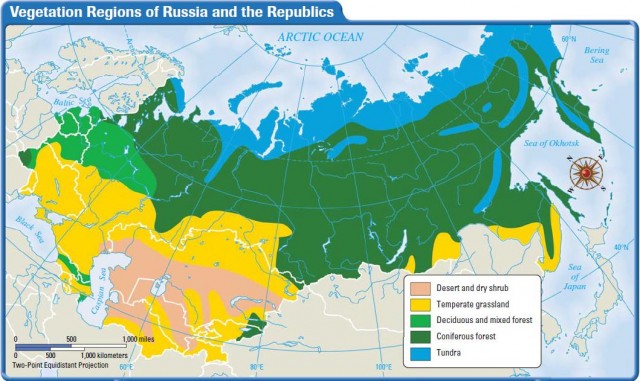Russia and the Republics: Climate and Vegetation
A HUMAN PERSPECTIVE Large areas of Russia and the Republics are extremely cold during much of the year. For example, the Siberian town of Oymyakon has reportedly had temperatures as low as –95°F. At such temperatures, the cold can crack steel and cause tires to explode. When you exhale, your breath freezes into crystals that fall to the ground and make a noise that Siberians call “the whispering of the stars.” Some of the region's native peoples believe that, in the coldest weather, words themselves freeze, and that, when warmer weather arrives and thaws the crystals, the words come to life and begin to speak. “Suddenly the air fills with out-of-date gossip, unheard jokes, and cries of forgotten pain.”
A Climate of Extremes
As you can see on the climate map on page 340, Russia and the Republics have some very cold climates. But the region also features warmer climates, such as the subtropical areas of Transcaucasia, and the semiarid and desert zones of Central Asia.
MAJOR CLIMATE REGIONS
Humid continental and subarctic climates dominate much of Russia and the Republics. These climates reflect the influence of the region's high latitude and the impact of the wall of mountains in the southeast. The region's enormous size also has a major effect on its climates. Much of the region is hundreds of miles from the moderating influence of the sea. The effect of this distance on climate is called continentality.
Distance from the sea affects the amount of precipitation the region gets, as well as its temperatures. Most of the region's moisture comes from the Atlantic Ocean. But the air coming from the ocean loses its moisture as it travels farther and farther inland.

Distance from the seas also results in extreme temperatures. In Siberia, average monthly temperatures rarely exceed 50°F and sometimes drop below -90°F. The long stretches of cold weather in the region have a unique impact on daily life. Siberians, for example, use frozen rivers and lakes as roads for part of the year. Temperatures are so consistently low that the region is covered by a layer of permanently frozen subsoil called permafrost. This layer can reach depths of 1,500 feet.
While humid continental and subarctic climates dominate the northern and eastern areas of the region, Russia and the Republics also have warmer climates. A wall of mountains in the southeastern areas of the region blocks moist air traveling northward from the Indian and Pacific oceans. The mountains contribute to the semiarid and desert climates of Central Asia.
In Transcaucasia, moist air from the Mediterranean Sea contributes to a subtropical climate zone. The region's health resorts were a favorite destination of tourists until ethnic conflict made traveling there dangerous.
Vegetation Regions
Russia and the Republics have four major vegetation regions. These regions run east to west in wide strips. Moving from north to south, they are the tundra, forest, temperate grassland, and desert.
TUNDRA
The tundra region of Russia and the Republics falls mostly in the Arctic climate zone. Only specific types of vegetation—such as mosses, lichens, small herbs, and low shrubs—are able to survive in the tundra's polar conditions.
FOREST
South of the tundra lies the largest forest on earth—the taiga. The taiga contains primarily coniferous trees. Many fur-bearing animals, such as sable, fox, and ermine, live in the taiga. Elk, bear, and wolves also make their homes in the forest.
South of the taiga, deciduous trees begin to mix with coniferous species. In lower latitudes, the deciduous trees become dominant.
STEPPE
The steppe is the name of the temperate grassland that extends from southern Ukraine through northern Kazakhstan to the Altay Mountains. The highly fertile chernozem soil is found in the steppe and helps to make the grassland a major source of grain for Russia and the Republics.
DESERT
Deserts and semiarid lands occupy the wide plains in the west and central areas of Central Asia. The two main deserts are the Kara Kum, which covers most of the republic of Turkmenistan, and the Kyzyl Kum, which is located in western Uzbekistan. Together, the two deserts occupy an area of about 230,000 square miles. In the following section, you will learn how efforts to irrigate these regions resulted in one of the world's greatest environmental catastrophes.